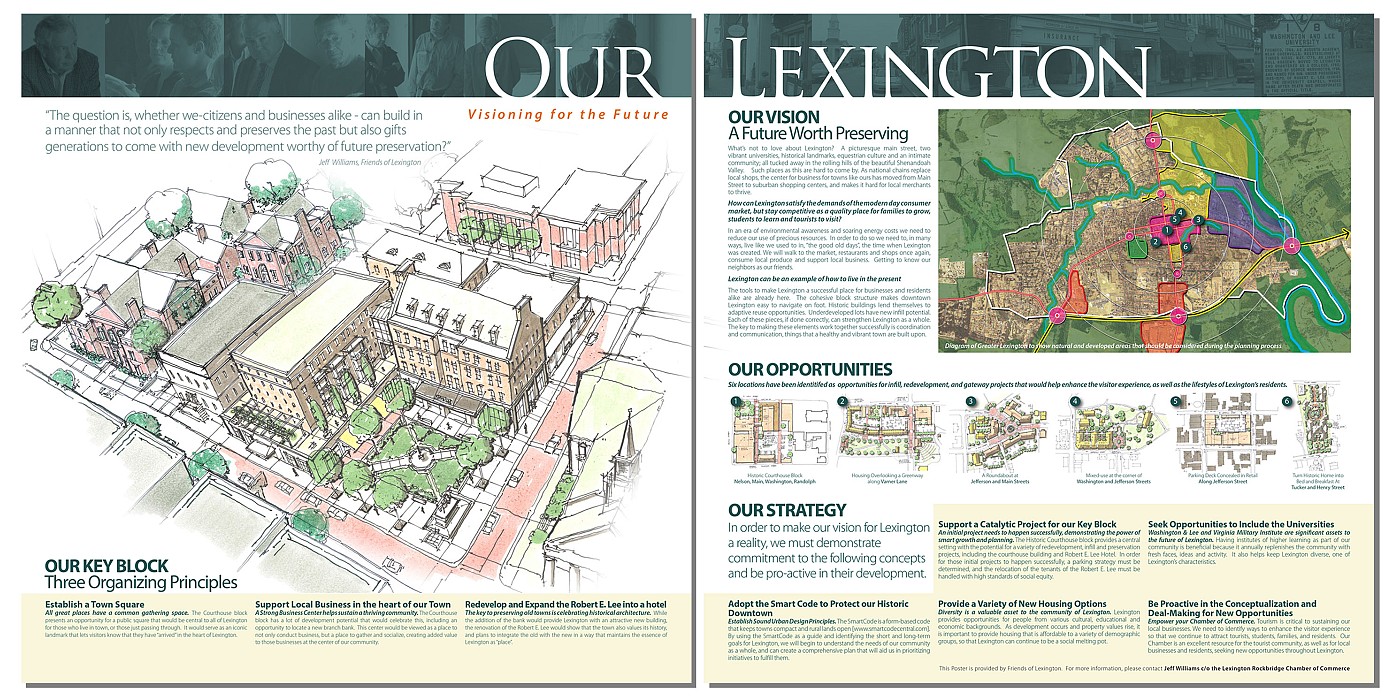- You have not saved any projects.
Friends Of Lexington, LLC
Friends of Lexington, LLC, essentially a group of community members with an affection for downtown Lexington, VA, came to Shook Kelley seeking services in vision planning for their historic downtown. They had goals to revive and restore this small community, where local merchants were threatened by suburban development; a story common to many charming small towns in our country.



Shook Kelley spent four days in Lexington, administering a Vision Workshop: getting to know the town, working with community members and businesses, and gaining an understanding of the things near and dear to the "Place" of Lexington. Studies were conducted to identify the areas of the community what would benefit most from improvement; whether it be through new buildings and services, infill projects or renovation.
Through the workshop, it became apparent that the tools to make Lexington a successful place for both its businesses and residents alike were already there. A cohesive block structure makes the downtown easy to navigate on foot. The historic buildings lend themselves to adaptive reuse opportunities. Underdeveloped lots have new infill potential. Each of these pieces, if done correctly, can strengthen the downtown as a whole.
As a result, Shook Kelley and Friends of Lexington developed a strategic plan with key concepts in order to making the new vision for Lexington a reality. The first concept involved a plan to adopt the Smart Code to protect the historic downtown, by establishing sound urban design principles. The second concept for the town was to support a catalyst project for the courthouse block, which was identifed through the workshop as a key area for redevelopment. For this catalyst effort to work, three Organizing Principles were outlined. First, establish a town square as a common gathering space. The courthouse block presents an opportunity for a public square that would serve as an iconic landmark for residents and visitors alike to know that they have "arrived" in the heart of downtown. Second, support the local businesses in the town center. The courthouse block also has the potential for added development to not only conduct business, but as a place to gather and socialize, creating added value to the businesses at the center. And third, redevelop and expand the historic Robert E. Lee building into a hotel, to show that Lexington values its history, by integrating the old with the new in a way that maintains the essence of Lexington as a Place. The third concept involved the provision of a variety of new housing options to create diversity, a valuable asset to the community. Fourth was to seek opportunities to include the two local Universities, Washington & Lee, and The Virginia Millitary Institute, into the mix of the downtown, replenishing the community with fresh faces and ideas annually. And lastly, remain steadast and proactive in the conceptualization and dealmaking for new opportunities by empowering Lexington's Chamber of Commerce, an excellent resource for tourism, as well as local businesses and residents alike.
Concluding the Vision Workshop, Shook Kelley prepared a vision poster for Friends Of Lexington to display around town, which documented the goals established for the community through the process.
Shook Kelley spent four days in Lexington, administering a Vision Workshop: getting to know the town, working with community members and businesses, and gaining an understanding of the things near and dear to the "Place" of Lexington. Studies were conducted to identify the areas of the community what would benefit most from improvement; whether it be through new buildings and services, infill projects or renovation.
Through the workshop, it became apparent that the tools to make Lexington a successful place for both its businesses and residents alike were already there. A cohesive block structure makes the downtown easy to navigate on foot. The historic buildings lend themselves to adaptive reuse opportunities. Underdeveloped lots have new infill potential. Each of these pieces, if done correctly, can strengthen the downtown as a whole.
As a result, Shook Kelley and Friends of Lexington developed a strategic plan with key concepts in order to making the new vision for Lexington a reality. The first concept involved a plan to adopt the Smart Code to protect the historic downtown, by establishing sound urban design principles. The second concept for the town was to support a catalyst project for the courthouse block, which was identifed through the workshop as a key area for redevelopment. For this catalyst effort to work, three Organizing Principles were outlined. First, establish a town square as a common gathering space. The courthouse block presents an opportunity for a public square that would serve as an iconic landmark for residents and visitors alike to know that they have "arrived" in the heart of downtown. Second, support the local businesses in the town center. The courthouse block also has the potential for added development to not only conduct business, but as a place to gather and socialize, creating added value to the businesses at the center. And third, redevelop and expand the historic Robert E. Lee building into a hotel, to show that Lexington values its history, by integrating the old with the new in a way that maintains the essence of Lexington as a Place. The third concept involved the provision of a variety of new housing options to create diversity, a valuable asset to the community. Fourth was to seek opportunities to include the two local Universities, Washington & Lee, and The Virginia Millitary Institute, into the mix of the downtown, replenishing the community with fresh faces and ideas annually. And lastly, remain steadast and proactive in the conceptualization and dealmaking for new opportunities by empowering Lexington's Chamber of Commerce, an excellent resource for tourism, as well as local businesses and residents alike.
Concluding the Vision Workshop, Shook Kelley prepared a vision poster for Friends Of Lexington to display around town, which documented the goals established for the community through the process.